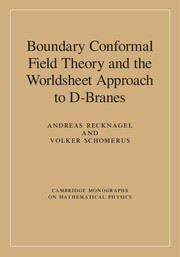Book contents
- Frontmatter
- Dedication
- Contents
- Introduction
- 1 Free field theory with boundaries
- 2 Superstrings and branes
- 3 Conformal field theory on the plane
- 4 Boundary conformal field theory
- 5 Perturbations of boundary conformal field theories
- 6 The Wess–Zumino–Witten model on SU(2)
- 7 Gepner model boundary states and Calabi–Yau branes
- Appendix
- References
- Index
2 - Superstrings and branes
Published online by Cambridge University Press: 05 November 2013
- Frontmatter
- Dedication
- Contents
- Introduction
- 1 Free field theory with boundaries
- 2 Superstrings and branes
- 3 Conformal field theory on the plane
- 4 Boundary conformal field theory
- 5 Perturbations of boundary conformal field theories
- 6 The Wess–Zumino–Witten model on SU(2)
- 7 Gepner model boundary states and Calabi–Yau branes
- Appendix
- References
- Index
Summary
Our main goal in the opening chapters is twofold: namely, to introduce some very basic concepts of boundary conformal field theory (CFT); and to link them to developments in string theory. We have now dispensed with the first task, as far as is possible without the more advanced technology we will provide in Chapters 3 and 4.
Here, we will link the main concepts of the previous chapter, such as boundary conditions, boundary states and boundary excitations, to target space concepts in string theory. Before that, we will sketch some of the very basics of string theory, mostly dating back to the 1970s and 1980s. Obviously, our exposition cannot serve as a textbook introduction to string theory, but we hope that it is useful for those readers who have been exposed to string theory only sporadically.
After sketching various approaches to first-quantised closed strings and the route from CFT correlators to string scattering amplitudes and effective actions, including supergravity, we turn to D-branes. We start with solitonic p-branes and their low-energy effective action, then try to set up a dictionary between notions from target space physics and various worldsheet quantities that occurred in the first chapter.
Some more technical background material needed to build models with target space supersymmetry, and an analysis of brane-brane scattering based on CFT partition functions, are collected at the end of this chapter.
- Type
- Chapter
- Information
- Publisher: Cambridge University PressPrint publication year: 2013



